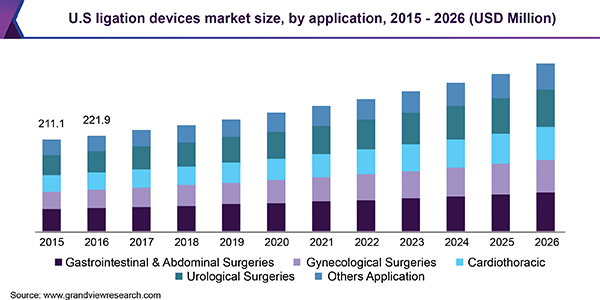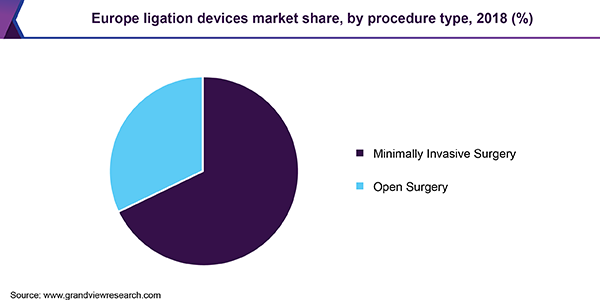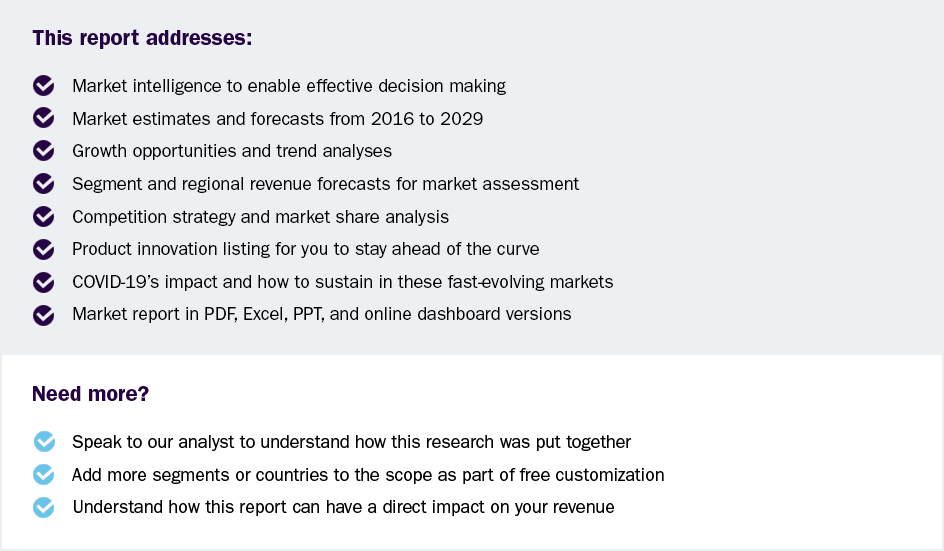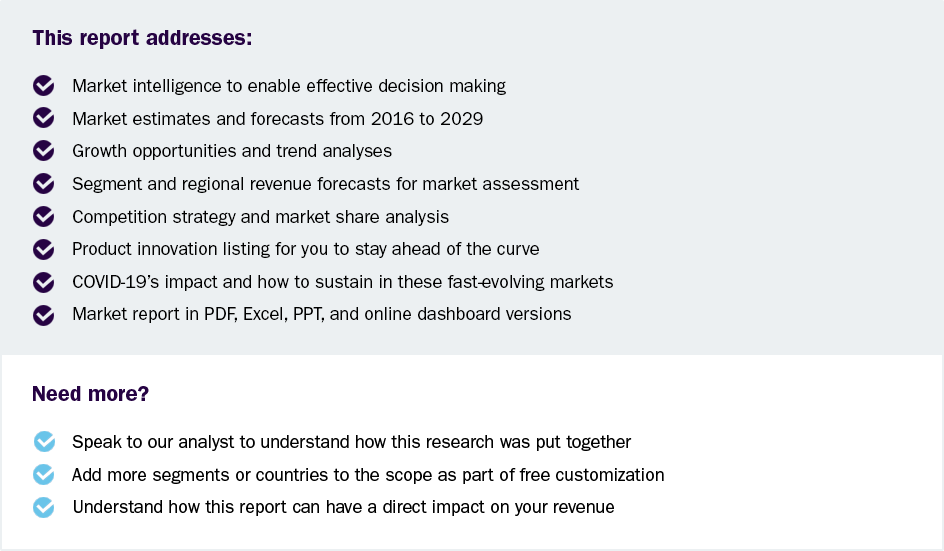- Home
- »
- Medical Devices
- »
-
Ligation Devices Market Size, Share & Trends Report, 2029GVR Report cover
![Ligation Devices Market Size, Share & Trends Report]()
Ligation Devices Market Size, Share & Trends Analysis Report by Product (Appliers, Accessories), By Application (GIT, Gynecology, Cardiothoracic, Urology), By Procedure Type (MIS, Open), By End Use, And Segment Forecasts, 2022 - 2029
- Report ID: GVR-4-68038-072-9
- Number of Report Pages: 110
- Format: PDF, Horizon Databook
- Historical Range: 2017 - 2020
- Forecast Period: 2022 - 2029
- Industry: Healthcare
Report Overview
The global ligation devices market size was valued at USD 1.4 billion in 2021 and is expected to grow at a compound annual growth rate (CAGR) of 6.20% from 2022 to 2029. A rise in surgical procedures and minimally invasive procedures is anticipated to drive the growth. The market is also driven by the increasing number of gastrointestinal, gynecological, urological, and cardiac surgery procedures that requires ligation devices for diagnosis and treatment. Furthermore, significant rise in the prevalence of aging associated diseases and rise in demand for endoscopic procedures requiring ligation devices are also the factors propelling the devices market.

Ligation is a surgical procedure of tying a ligature around duct, tube or blood vessel in the body. Endoscopic ligation is an effective method for the treatment of protuberant lesions and is widely used as a management of bleeding esophageal, gastric varices, and angiodysplasia. It is a feasible method for removing upper gastrointestinal lesions. It also reduces the risk of related complications, such as perforation and hemorrhage.
Factors, such as several government initiatives and increasing healthcare spending for the treatment of digestive system related diseases are also anticipated to propel the market growth. In 2015, Hepatitis (USD 23.3 billion), esophageal disorder (USD 18.1 billion), biliary tract diseases (USD 10.3 million), and abdominal pain (USD 10.2 billion) were the most expensive categories of healthcare expenditure in U.S. There are more than 40.7 million ambulatory visits for GI disease in U.S. each year. In 2017, the National Institute of Health (NIH) funded USD 1.8 billion for research in digestive diseases in the country.
Geriatric population is considered to be more prone to digestive disorders and chronic conditions. The rise in global geriatric population is expected to create a high impact on ligation devices market. In addition, the high adoption rate of minimally invasive surgeries, especially for the geriatric patients is expected to boost the growth. According to the National Institutes of Health (NIH), in 2015, there were 617 million people over the age of 65 years, which is 8.5% of the total population. The number is projected to reach 1.6 billion by 2050. The aforementioned factors are expected to drive the market growth during the forecast period.
Application Insights
The gastrointestinal and abdominal surgery segment captured the majority of the market share in 2018 and is expected to dominate the market during the forecast period. The high market size is primarily attributed to the rising prevalence of age-related diseases coupled with the rising demand for ligation devices in therapeutic and diagnostic of gastrointestinal procedures.
The cardiothoracic segment is expected to expand at the fastest CAGR during the forecast period driven by the increasing incidence of heart-related diseases along with an increasing number of procedures. The ligation devices can also be used in open surgery, such as repair of a faulty heart valve or to bypass blocked arteries. Furthermore, an increasing number of non-invasive heart surgeries are also propelling the market. Patients with atrial fibrillation are often recommended a procedure known as left atrial appendage closure. The pericardial ligation procedure works with the lariat device and does not require an open-heart surgery, thereby minimizing post-operative complications. The aforementioned factors are anticipated to propel the growth.
End Use Insights
The hospitals segment dominated with more than 75% market share in 2018. The key drivers of the segment are increasing number of procedures, rise in healthcare spending, and growing number of hospitals. According to the American Hospital Association (AHA), there were 6,200 active hospitals in U.S in 2017, an increase from 5,534 hospitals in 2016.
Ambulatory Surgical Centers (ASCs) segment also captured considerable market share in 2018. The segment is expected to register the highest CAGR during the forecast period. Factors contributing to the high growth include increasing number of outpatient procedures and rising adoption of minimally invasive surgeries, which do not require longer hospital stays. In addition, 20% to 50% cost savings in ASCs compared to the cost involved to perform the same procedure in hospitals is also anticipated to drive the segment growth over the forecast period.
Product Insights
The accessories segment accounted for the largest market share of more than 55% and is expected to expand at the fastest pace during the forecast period. The accessories segment is further divided into clips and clip removers. The clips segment dominated the market in 2018 and is also expected to register a high growth rate. Availability of these clips in a variety of sizes and multiple use in single procedures is anticipated to drive the segment growth.
Appliers segment also has considerable market share and is expected to expand at a CAGR of 5.99% during the forecast period. The segment is further divided into disposable and reusable appliers. Reusable appliers account for the largest market size and is expected to dominate the market during the forecast period, primarily attributed to the product usage in both minimally invasive and open surgery.
Procedure Type Insights
MIS procedures accounted for the largest market share in 2018 due to benefits, such as quick recovery time and reduced post-operative cost. MIS procedures are also associated with shorter hospital stays and lower chances of readmission, surgical site infection, pain, and mortality. Other benefits, such as requirement of small incision and reduced blood loss during the procedure are also driving the segment growth.

The open surgery segment accounted for a considerable share of the market for ligation services in 2018 and is expected to grow at a rapid pace over the forecast period. The high growth rate is primarily attributed to the increasing incidence of heart disease and the rising number of open-heart surgeries. Ligation devices are used in various types of open heart surgeries, such as Coronary Artery Bypass Graft (CABG), aortic valve replacement, and mitral valve replacement. According to the Society of Thoracic Surgeons Adult Cardiac Surgery database, in U.S., a total of 156,931 CABG procedures were performed in 2016, thus driving the uptake of ligation devices.
Regional Insights
North America dominated in 2018 owing to the high cost of treatment and the increasing number of procedures. U.S. spearheaded with over 75.0% regional market share in the same year. Furthermore, increasing government spending and the presence of key players is also propelling the market growth. In 2015, healthcare expenditure to gastrointestinal conditions was totaled USD 135 billion, which was much higher than other common diseases.
Asia Pacific is expected to register the fastest growth during the forecast period. The high growth rate is primarily attributed to the increasing prevalence of gastrointestinal diseases which can be treated by minimally invasive techniques using ligation devices. These devices are used in many endoscopic procedures. Several Asian companies are focusing on development of GI specialized products and are targeting emerging countries. For instance, Japanese company Olympus, a manufacturer of endoscopic devices, established a new factory in Vietnam as well as multiple training centers in India and China.
Key Companies & Market Share Insights
The players are focusing on new product launches to provide advanced services to the Ligation devices patient. In August 2019, Medtronic Plc confirmed the re-availability of its two product codes FF107- ligation clip applier, and FFL112-ligation clip applier. Some of the prominent players in the ligation devices market include:
-
Medtronic Plc
-
Johnson and Johnson (Ethicon)
-
the Cooper Companies, Inc.
-
CONMED Corporation
-
B Braun Melsungen AG
-
Teleflex Incorporated
-
Olympus Corporation
RECENT DEVELOPMENTS
-
In February 2022, Cooper Companies announced the acquisition of Cook Medical’s Reproductive Health business, a manufacturer of invasive medical devices that focuses on gynecology. These new devices fit perfectly in the operations and helped Cooper Surgical to improve its international fertility footprint.
-
In August 2022, CONMED Corporation acquired Biorez, a biotechnology company. This acquisition helped CONMED to have access to cutting-edge bioinductive collagen scaffold technology for use in sports medicine soft tissue recovery.
-
In October 2022, Teleflex announced its acquisition of Standard Bariatrics. The acquisition enabled Teleflex to leverage Standard Bariatrics strength in its existing bariatric surgeon call point, with a differentiated product that complements many of its key surgical products, including ligation portfolio.
-
In November 2021, Cooper Companies acquired General Life Sciences, a global life science company. This acquisition helped the company to better serve the clinics and Ob/Gyns with a greater variety of goods and services.
Ligation Devices Market Report Scope
Report Attribute
Details
Market size value in 2021
USD 1.4 billion
Revenue forecast in 2029
USD 1.7 billion
Growth Rate
CAGR of 6.2% from 2022 to 2029
Base year for estimation
2021
Historical data
2017 - 2020
Forecast period
2022 - 2029
Quantitative units
Revenue in USD billion and CAGR from 2022 to 2029
Report coverage
Revenue forecast, company ranking, competitive landscape, growth factors, and trends
Segment Scope
Product, application, procedure type, end use, region
Region scope
North America; Europe; Asia Pacific; Latin America; MEA
Country scope
U.S.; Canada; UK; Germany; France; Italy; Spain; Japan; China; India; Australia; South Korea; Brazil; Mexico; Argentina; Colombia; South Africa; Saudi Arabia; UAE
Key companies profiled
Medtronic Plc; Johnson and Johnson (Ethicon); the Cooper Companies, Inc.; CONMED Corporation; B Braun Melsungen AG; Teleflex Incorporated; Olympus Corporation
Customization scope
Free report customization (equivalent up to 8 analysts working days) with purchase. Addition or alteration to country, regional & segment scope.
Pricing and purchase options
Avail customized purchase options to meet your exact research needs.Explore purchase options
Segments Covered in the Report
This report forecasts revenue growth at global, regional, and country levels as well as provides an analysis of the latest industry trends in each of the sub-segments from 2015 to 2026. For the purpose of this study, Grand View Research has segmented the global ligation devices market report on the basis of product, application, procedure type, end use, and region:
-
Product Outlook (Revenue, USD Million, 2017 - 2029)
-
Appliers
-
Disposable
-
Reusable
-
-
Accessories
-
Clips
-
Clip Remover
-
-
-
Application Outlook (Revenue, USD Million, 2017 - 2029)
-
Gastrointestinal and Abdominal Surgery
-
Gynecological Surgery
-
Cardiothoracic Surgery
-
Urological Surgery
-
Other
-
-
Procedure Type Outlook (Revenue, USD Million, 2017 - 2029)
-
MIS
-
Open Surgery
-
-
End Use Outlook (Revenue, USD Million, 2017 - 2029)
-
Hospitals
-
Ambulatory Surgical Centers
-
-
Regional Outlook (Revenue, USD Million, 2017 - 2029)
-
North America
-
U.S.
-
Canada
-
-
Europe
-
U.K.
-
Germany
-
France
-
Italy
-
Spain
-
-
Asia Pacific
-
Japan
-
China
-
India
-
Australia
-
South Korea
-
-
Latin America
-
Brazil
-
Mexico
-
Argentina
-
Colombia
-
-
Middle East & Africa
-
South Africa
-
Saudi Arabia
-
UAE
-
-
Frequently Asked Questions About This Report
b. The global ligation devices market size was valued at USD 910.5 million in 2019 and is expected to reach USD 964.7 million in 2020.
b. The global ligation devices market is expected to grow at a compound annual growth rate of 6.3% from 2019-2026 to reach USD 1,398.5 million in 2026.
b. North America dominated the ligation devices market with a share of 36.4% in 2019. This is attributable to increasing government spending and the presence of key players in the region.
b. Key companies operating in the market are Medtronic Plc; Johnson and Johnson (Ethicon); the Cooper Companies, Inc.; CONMED Corporation; B Braun Melsungen AG; Teleflex Incorporated; and Olympus Corporation.
b. Key factors that are driving the market growth include increasing number of minimally invasive procedures, increasing prevalence of digestive diseases, technological advancements and rising healthcare spending.
Share this report with your colleague or friend.
![gvr icn]()
NEED A CUSTOM REPORT?
We can customize every report - free of charge - including purchasing stand-alone sections or country-level reports, as well as offer affordable discounts for start-ups & universities. Contact us now
![Certified Icon]()
We are GDPR and CCPA compliant! Your transaction & personal information is safe and secure. For more details, please read our privacy policy.
We are committed towards customer satisfaction, and quality service.
"The quality of research they have done for us has been excellent."






